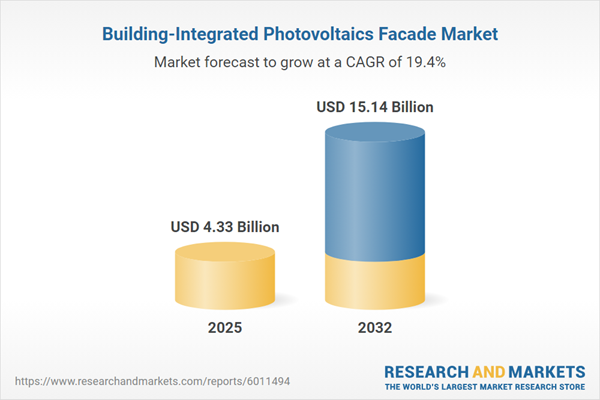Speak directly to the analyst to clarify any post sales queries you may have.
The building-integrated photovoltaics facade market is rapidly transforming the integration of renewable energy with modern architecture, offering senior decision-makers actionable insights into technology adoption, supply dynamics, and regulatory shifts shaping this sector.
Market Snapshot: Building-Integrated Photovoltaics Facade Market
In recent years, the building-integrated photovoltaics facade market has experienced significant momentum, driven by escalating global urbanization and shifting policy landscapes. Between 2024 and 2025, the sector saw strong growth, with a clear trajectory toward substantial expansion through 2032, reinforced by robust adoption rates and advances in technology. These trends reflect concerted industry initiatives and supportive regulatory actions propelling this market forward at an accelerated pace.
Scope & Segmentation
This analysis provides a detailed forecast of revenues and market trends by examining all levels of segmentation. Each facet is crucial to identifying high-growth opportunities and understanding unique deployment challenges.
- Technology Type: Crystalline silicon (monocrystalline and polycrystalline) BIPV, thin-film BIPV (amorphous silicon, cadmium telluride, copper indium gallium selenide)
- Component: PV modules, inverters, mounting structures
- Material Type: Glass, metal, polymer
- Design: Opaque, semi-transparent, and transparent BIPV facades
- Installation Type: New construction and retrofit installation
- End-User: Commercial (office and retail spaces), industrial (manufacturing facilities, warehouses), institutional, residential
- Regional Coverage: Americas (North America, Latin America), Europe, Middle East & Africa (Europe, Middle East, Africa), Asia-Pacific (China, India, Japan, Australia, South Korea, Indonesia, Thailand, Malaysia, Singapore, Taiwan)
- Key Vendors: Includes Aesthetic Green Power, AGC Inc., BIPVco, Canadian Solar, Elemex Architectural Facade Systems, Ertex-Solar, Hanergy Thin Film Power Group, Hanwha Q CELLS, Onyx Solar, SunPower, Tesla, Waaree Energies, and others
Key Takeaways: Strategic Insights for Decision-Makers
- Urban growth and decarbonization initiatives are placing building-integrated photovoltaics facade solutions at the center of sustainable architectural strategies, transforming facades into multi-functional assets.
- Material and design innovations, including advanced crystalline cells and flexible thin-film laminates, now accommodate a broad spectrum of transparency, performance, and architectural needs.
- Collaboration among architects, façade consultants, and solar engineers is crucial to successfully integrate photovoltaic modules into complex geometries, aligning visual appeal and energy targets.
- Smart digital management platforms are increasingly embedded with facade-integrated photovoltaics systems, enabling real-time analytics, predictive maintenance, and optimal energy dispatch capabilities.
- Lifecycle sustainability, recyclability, and alignment with circular economy principles are gaining prominence in product development, supporting broader environmental and certification goals.
- Balanced procurement strategies and adaptive contracting models are essential for mitigating supply uncertainties, supporting reliable and scalable deployment.
Tariff Impact on the Building-Integrated Photovoltaics Facade Market
Recent United States tariff measures on photovoltaic imports are reshaping global supply chains and prompting greater investment in nearshore and domestic production capabilities. Developers and integrators now prioritize proactive procurement strategies to manage price volatility and maintain project timelines. These dynamics drive innovations in sourcing, manufacturing efficiency, and cross-border collaborations, ensuring a resilient supply network despite evolving trade policies.
Methodology & Data Sources
This report employs a robust mixed-method approach, combining structured primary interviews with sector leaders and on-site validation visits, alongside in-depth reviews of industry publications, public databases, regulatory filings, and academic research. Quantitative scenario modeling and expert peer review underpin all market projections, ensuring credible, actionable insights tailored to the unique context of building-integrated photovoltaics facade adoption.
Why This Report Matters for Senior Decision-Makers
- Supports strategic planning by providing an integrated view of technology trends, policy shifts, and regional market dynamics.
- Provides actionable intelligence to inform R&D investment, supply chain management, and stakeholder engagement across end-user verticals.
- Helps organizations mitigate risk by detailing the effects of evolving trade measures and market-entry routes for diverse architectural projects.
Conclusion
Building-integrated photovoltaics facade systems are redefining how urban environments generate and manage energy, delivering value for stakeholders committed to sustainability, design excellence, and operational efficiency. Utilizing these insights, organizations can align their strategies to harness emerging opportunities within the evolving energy and construction landscapes.
Additional Product Information:
- Purchase of this report includes 1 year online access with quarterly updates.
- This report can be updated on request. Please contact our Customer Experience team using the Ask a Question widget on our website.
Table of Contents
3. Executive Summary
4. Market Overview
7. Cumulative Impact of Artificial Intelligence 2025
Companies Mentioned
The companies profiled in this Building-Integrated Photovoltaics Facade market report include:- Aesthetic Green Power, Inc.
- AGC Inc.
- BIPVco
- Canadian Solar Inc.
- Elemex Architectural Facade Systems
- Ertex-Solar
- Hanergy Thin Film Power Group
- Hanwha Q CELLS Co.
- Heliartec Solutions Corporation, Ltd.
- Heliatek GmbH
- Issol Switzerland Ltd.
- Merck KGaA
- NanoPV Solar Inc.
- Nippon Sheet Glass Co., Ltd
- Onyx Solar
- PIXASOLAR
- Roofit.Solar
- Saule Technologies
- Schüco International KG
- SolarLab.global
- SolarScape Enterprises LLP
- Solarstone OÜ
- Soleos Solar Energy Pvt. Ltd.
- SunPower Corporation
- Tesla Inc.
- Waaree Energies Ltd.
- Zhejiang HIITIO New Energy Co., Ltd
Table Information
| Report Attribute | Details |
|---|---|
| No. of Pages | 187 |
| Published | November 2025 |
| Forecast Period | 2025 - 2032 |
| Estimated Market Value ( USD | $ 4.33 Billion |
| Forecasted Market Value ( USD | $ 15.14 Billion |
| Compound Annual Growth Rate | 19.4% |
| Regions Covered | Global |
| No. of Companies Mentioned | 28 |









